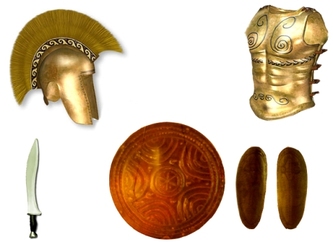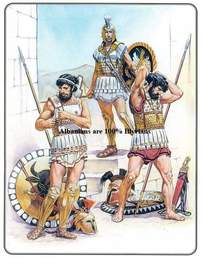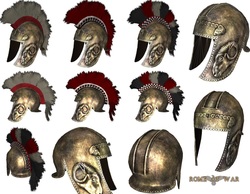Illyrian weapons

Illyrian weaponry played an important role in the makeup of Illyrian armies and in conflicts involving the Illyrians. Of all the ancients sources the most important and abundant writings are those of Ennius (239 -169 BC), a Roman poet of Messapian origin. Weapons of all sorts were also placed intact in the graves of Illyrian warriors and provide a detailed picture for archaeologists on the distribution and development of Illyrian weaponry.

Shields
Shields were used among the Illyrians from the end of the Bronze Age, but very little is known about the early shields until the Iron Age. In this period, Illyrian shields were made of wood and leather and as a result no such example has survived.During the Iron Age a metal plate-cover was attached to the shields. The most common Illyrian shield was the circular shield, although northern Illyrians and the Japodes also used an oval or rectangular type. The circular shield was small, and was decorated with embedded circles and semicircles on the sides. It resembled the Macedonian shield of the time, but differed in the number of circles, which were a symbolic decoration. One of the best examples of the Illyrian circular shield, coated in bronze, was found in a Liburnian necropolis in Nin and dates from the 4th century BC. The circular shield was widely used from Glasinac in Bosnia to Albania. They are depicted on Illyrian city coins of Lezhë and Shkodër. Similar to the Illyrian oval shield in northern Illyria was the shield that the Celts brought with them during the Gallic invasion of the Balkans in the 4th-3rd centuries BC. The Celtic shield was wooden and oblong, with an iron boss.[1][2]
Breast armor
Breast armour was a rare and very interesting part of Illyrian armor. A type of breast-armor made of bronze plate was only used by northern Illyrians. Up to now only three of these have been discovered in Novo Mesto, Sticna-Verpole and St. Vid. All date before 500 BC. Other Illyrian did not use breast armor. Only the Glasinac Illyrians used a type of breast armor if breast armor can be considered a jacket made of cloth or leather with parts of bronze. Another form of body armor was a bronze pectoral that may have protected part of the back as well. It was more like a disc "breastplate" of 10 cm in diameter.[3]
Greaves
In the 7th century BC, bronze greaves were used by Illyrian warriors. It is possible that Illyrians used leather greaves in an earlier time, the same as those used by the Mycenaeans, but nothing is known about them. Bronze greaves first appear among the Illyrians in southern Illyria where examples have been found dating to the 7th century BC, and also from Glasinac from the same period. The bronze greaves discovered in a prince's grave in Gllasinac are interesting especially for the decorations depicted on them. Warships, circles and triangular motives are carved on the outer surfaces. The two last-mentioned decorations were believed to protect the warrior while in combat. Up to the Roman era bronze greaves were rarely used and only by wealthy warriors.[3]
Helmets
Helmets are found more abundantly in Illyrian graves because of their higher status. Bronze helmets were made by the northern Illyrian from the 7th century BC. At that time and probably earlier the conical helmet was used. Later in these areas the Shmarjet helmet, named after Shmarjet of Novo Mesto, was used by the Japodes.[4]
Shields were used among the Illyrians from the end of the Bronze Age, but very little is known about the early shields until the Iron Age. In this period, Illyrian shields were made of wood and leather and as a result no such example has survived.During the Iron Age a metal plate-cover was attached to the shields. The most common Illyrian shield was the circular shield, although northern Illyrians and the Japodes also used an oval or rectangular type. The circular shield was small, and was decorated with embedded circles and semicircles on the sides. It resembled the Macedonian shield of the time, but differed in the number of circles, which were a symbolic decoration. One of the best examples of the Illyrian circular shield, coated in bronze, was found in a Liburnian necropolis in Nin and dates from the 4th century BC. The circular shield was widely used from Glasinac in Bosnia to Albania. They are depicted on Illyrian city coins of Lezhë and Shkodër. Similar to the Illyrian oval shield in northern Illyria was the shield that the Celts brought with them during the Gallic invasion of the Balkans in the 4th-3rd centuries BC. The Celtic shield was wooden and oblong, with an iron boss.[1][2]
Breast armor
Breast armour was a rare and very interesting part of Illyrian armor. A type of breast-armor made of bronze plate was only used by northern Illyrians. Up to now only three of these have been discovered in Novo Mesto, Sticna-Verpole and St. Vid. All date before 500 BC. Other Illyrian did not use breast armor. Only the Glasinac Illyrians used a type of breast armor if breast armor can be considered a jacket made of cloth or leather with parts of bronze. Another form of body armor was a bronze pectoral that may have protected part of the back as well. It was more like a disc "breastplate" of 10 cm in diameter.[3]
Greaves
In the 7th century BC, bronze greaves were used by Illyrian warriors. It is possible that Illyrians used leather greaves in an earlier time, the same as those used by the Mycenaeans, but nothing is known about them. Bronze greaves first appear among the Illyrians in southern Illyria where examples have been found dating to the 7th century BC, and also from Glasinac from the same period. The bronze greaves discovered in a prince's grave in Gllasinac are interesting especially for the decorations depicted on them. Warships, circles and triangular motives are carved on the outer surfaces. The two last-mentioned decorations were believed to protect the warrior while in combat. Up to the Roman era bronze greaves were rarely used and only by wealthy warriors.[3]
Helmets
Helmets are found more abundantly in Illyrian graves because of their higher status. Bronze helmets were made by the northern Illyrian from the 7th century BC. At that time and probably earlier the conical helmet was used. Later in these areas the Shmarjet helmet, named after Shmarjet of Novo Mesto, was used by the Japodes.[4]

Illyrian helmet
This very interesting type of helmet was similar to the Japodian round caps. They were made from the skeletons of bushes and painted with clay. Round bronze discs and studs were often embedded around the helmet. There were two varieties, one with a wicker base and one sewn together with chain mail. Up to now thirty Shmarjet helmets have been found. Among the northern Illyrians the bronze helmet developed into the conical or pot helmet.[5] The conical helmet was used in the 6th century BC and sometimes had a plume. From the 5th-4th century BC under the influence of the Etruscans and other Italik peoples, the Negau helmet was used also by the northern Illyrians. The Agrianes who were in close contact with the Macedons and Thracians used the Phrygian type helmet.
The most important and widespread helmet was the Illyrian helmet. Helmets of this type have been discovered in many sites in Albania, Bosnia, Croatia (near the coast), Macedonia, Kosovo and Serbia. The source of most of these helmets is Greece. Many scientists date the oldest Illyrian helmets from the 7th century BC Greece and according to them later helmets found in southern Illyria also from the 7th century BC are imports from Greece. However, other experts, especially the Albanian archaeologist Hasan Ceka, present arguments in favor of the indigenous Illyrian helmet. According to Ceka the Illyrian helmet is an original Illyrian type of helmet dating from the 7th century BC and used up to the 2nd century BC, and not only up to the 4th century BC, as thought earlier. Proof of such late use is offered by depictions of the helmet on Illyrian coins, especially those of king Gentius. Helmets were a privilege limited to the minority of warriors who could afford or obtain them.
This very interesting type of helmet was similar to the Japodian round caps. They were made from the skeletons of bushes and painted with clay. Round bronze discs and studs were often embedded around the helmet. There were two varieties, one with a wicker base and one sewn together with chain mail. Up to now thirty Shmarjet helmets have been found. Among the northern Illyrians the bronze helmet developed into the conical or pot helmet.[5] The conical helmet was used in the 6th century BC and sometimes had a plume. From the 5th-4th century BC under the influence of the Etruscans and other Italik peoples, the Negau helmet was used also by the northern Illyrians. The Agrianes who were in close contact with the Macedons and Thracians used the Phrygian type helmet.
The most important and widespread helmet was the Illyrian helmet. Helmets of this type have been discovered in many sites in Albania, Bosnia, Croatia (near the coast), Macedonia, Kosovo and Serbia. The source of most of these helmets is Greece. Many scientists date the oldest Illyrian helmets from the 7th century BC Greece and according to them later helmets found in southern Illyria also from the 7th century BC are imports from Greece. However, other experts, especially the Albanian archaeologist Hasan Ceka, present arguments in favor of the indigenous Illyrian helmet. According to Ceka the Illyrian helmet is an original Illyrian type of helmet dating from the 7th century BC and used up to the 2nd century BC, and not only up to the 4th century BC, as thought earlier. Proof of such late use is offered by depictions of the helmet on Illyrian coins, especially those of king Gentius. Helmets were a privilege limited to the minority of warriors who could afford or obtain them.
Also see
References
- Early Roman Armies (Men-at-Arms) by Nicholas Sekunda and Richard Hook, 1995, ISBN 1-85532-513-6, Colour plates, The Venetic fighting system, Fifth century BC
- a b The Illyrians: history and culture, History and Culture Series, The Illyrians: History and Culture, Aleksandar Stipčević, ISBN 0-8155-5052-9,1977, page 174, "Resembling the northern Illyrian oval shield was one introduced into Illyria by the Celts. Apart from the iron boss, nothing was preserved of these Celtic shields. It is known though that they were oblong shaped and made of wood with an umbo in the center"
- The Illyrians: History and Culture,Aleksandar Stipčević
- Wilkes, J. J. The Illyrians, 1992, ISBN 0-631-19807-5, page 234,"... Lika, 25 cm long c) Bronze temple-band from Gorica, Slovenia d) Japodian metal headgear from Kompolje, Lika ..."
- Peter Connoly, Greece & Rome at War, ISBN 1-85367-303-X, page 102-103
